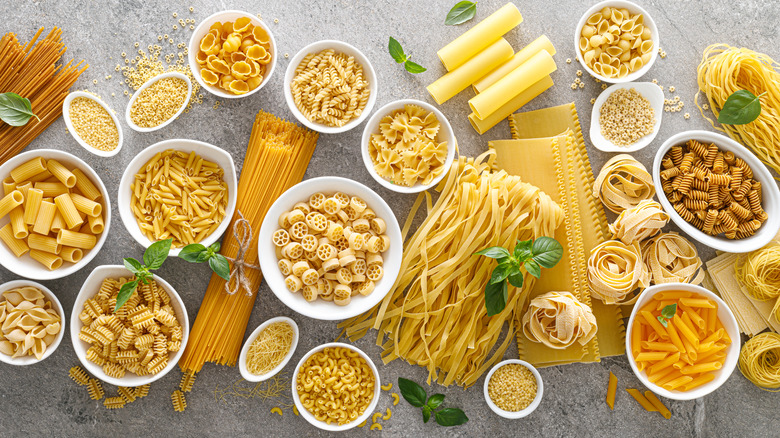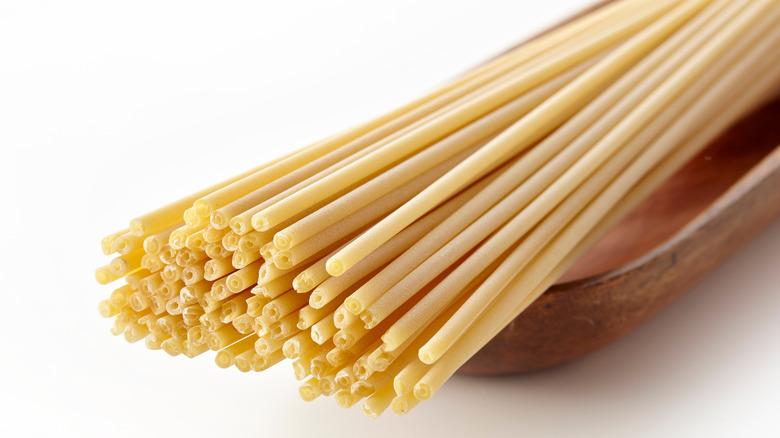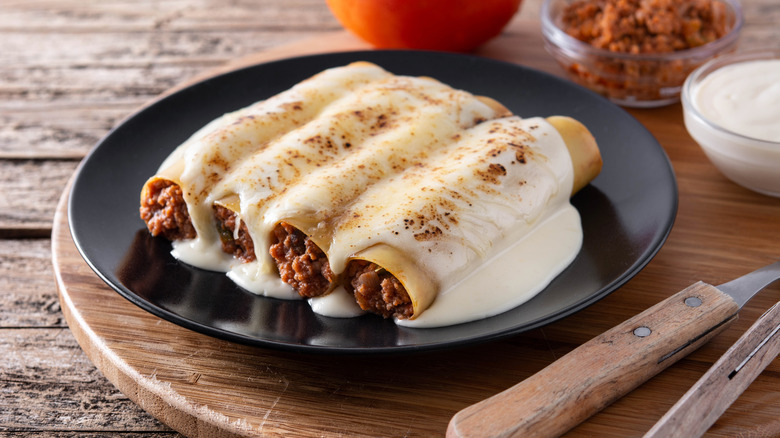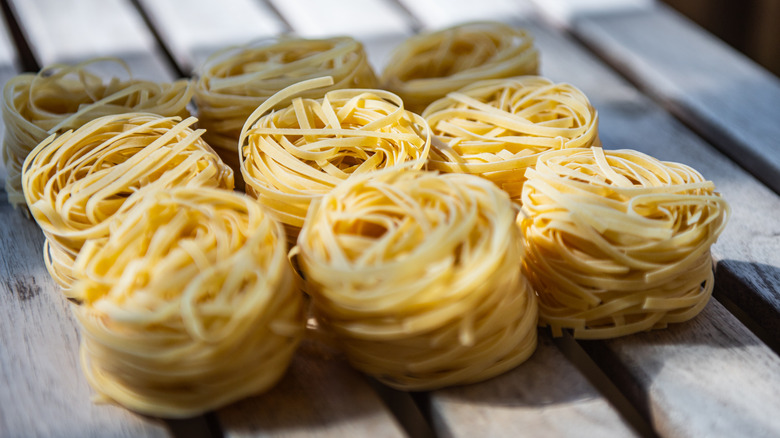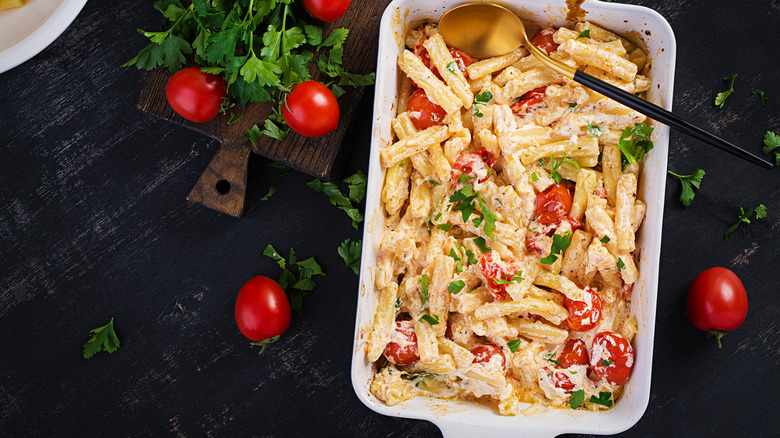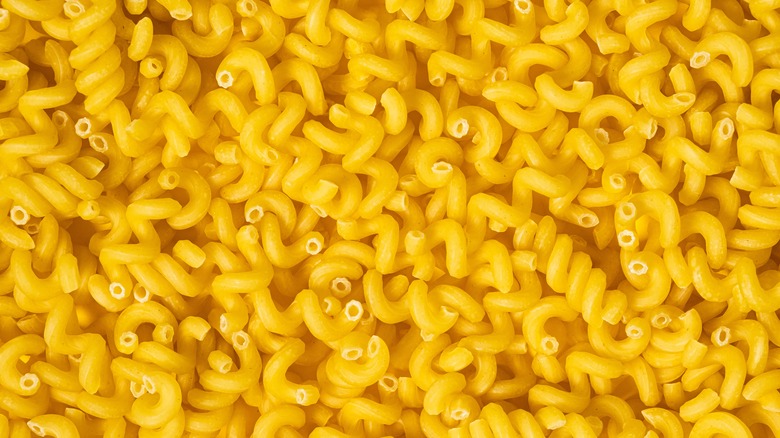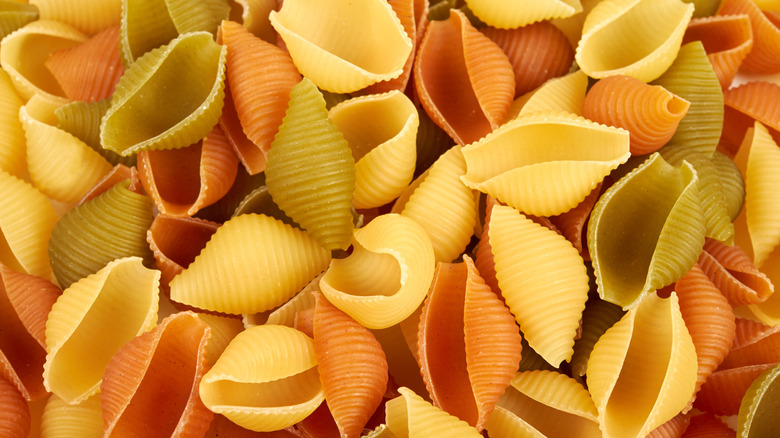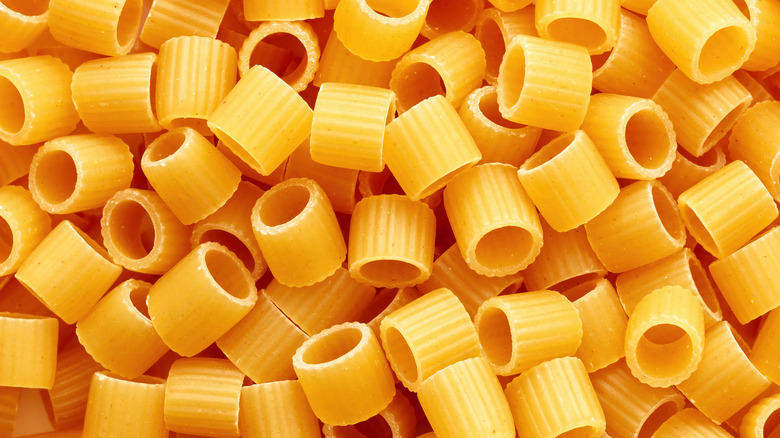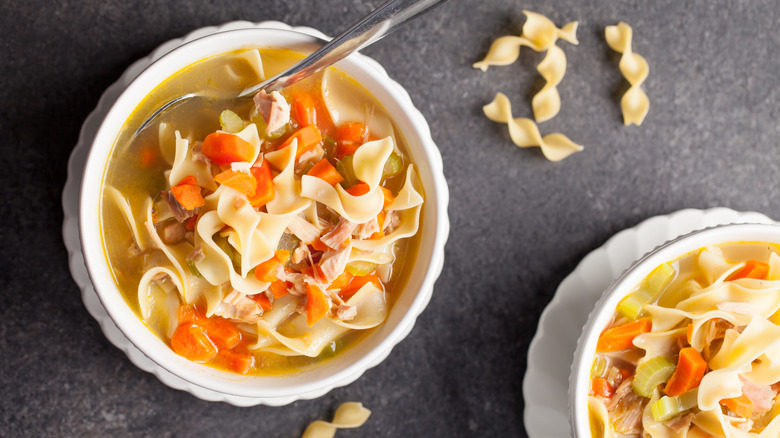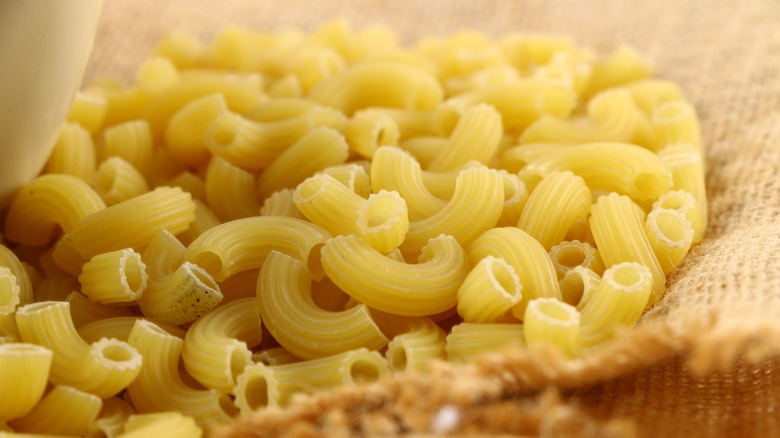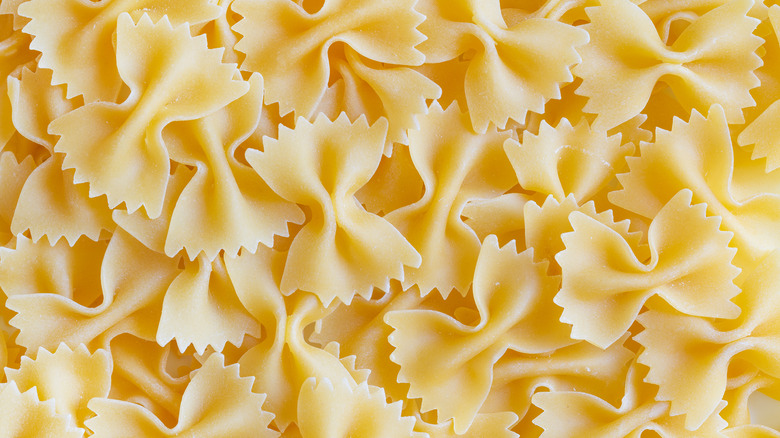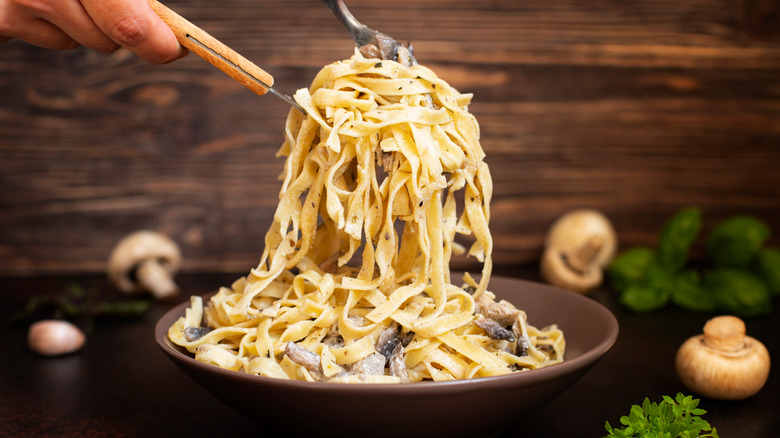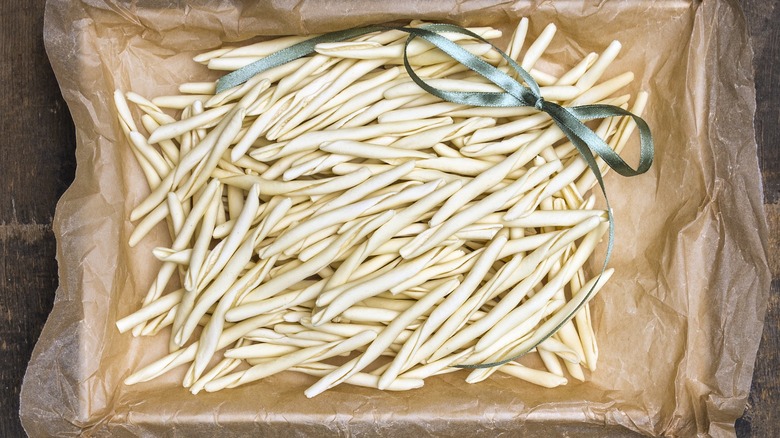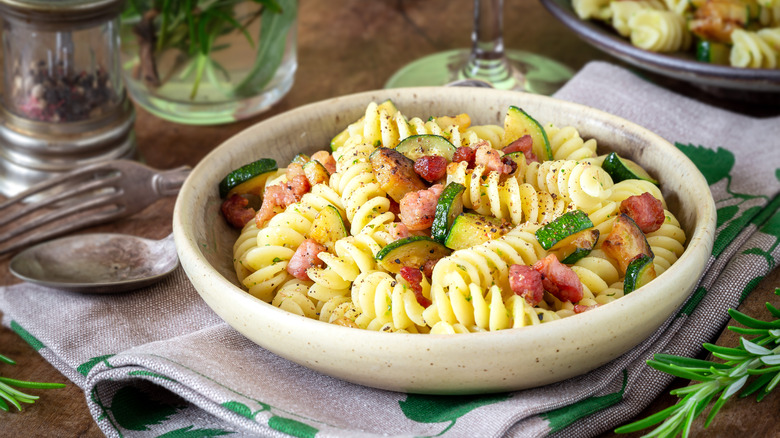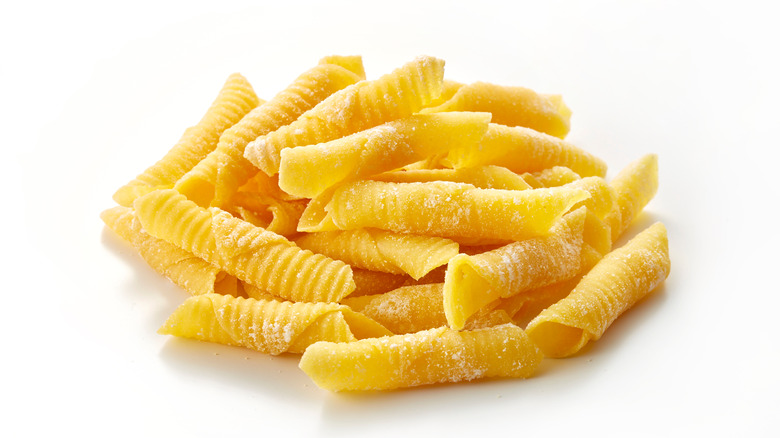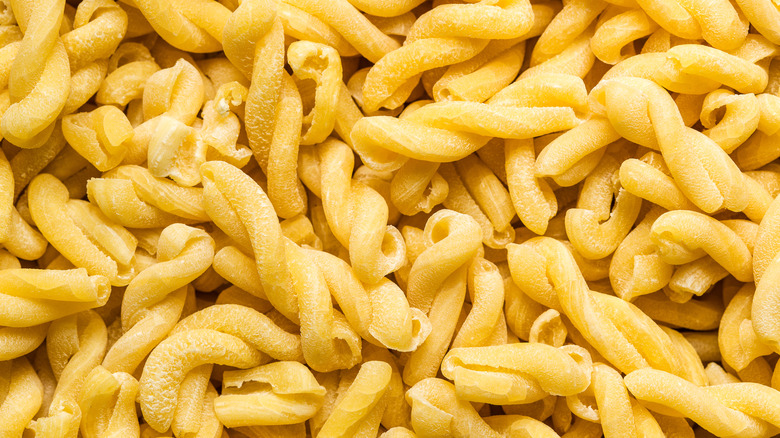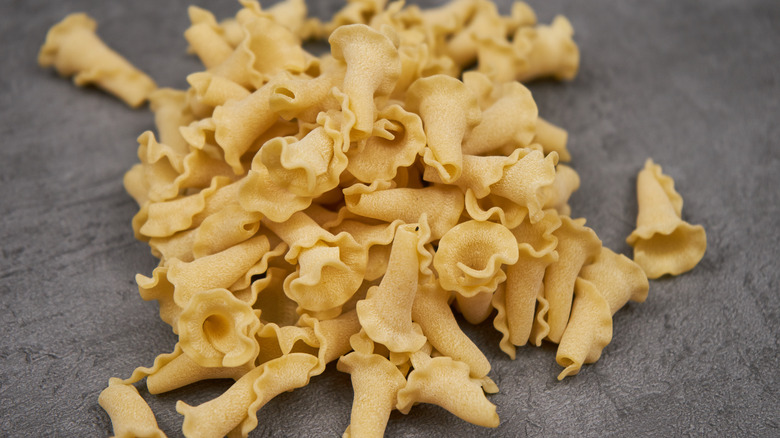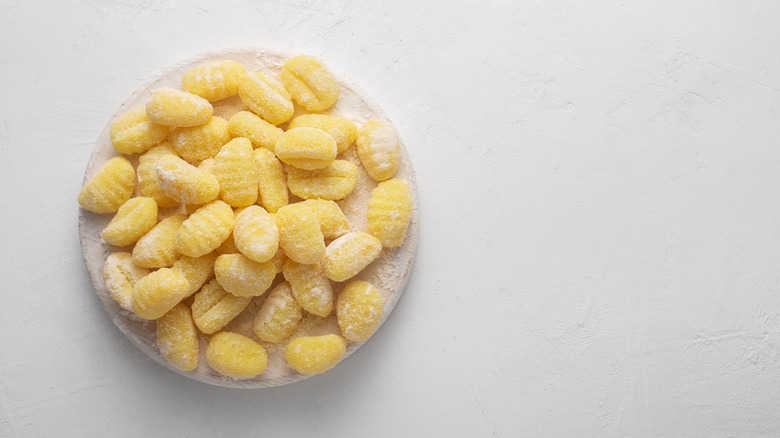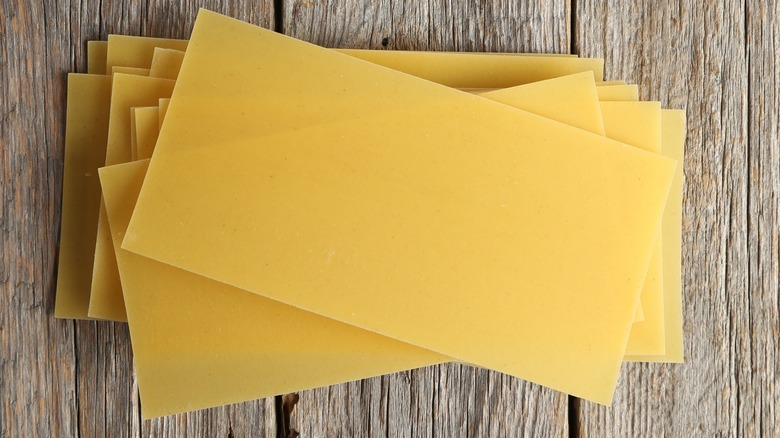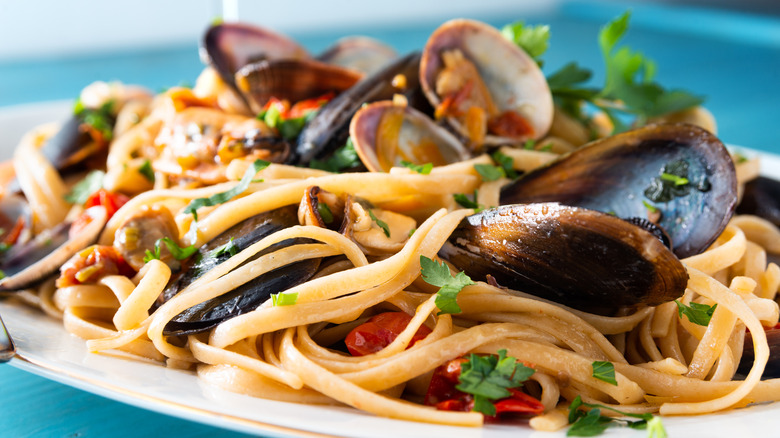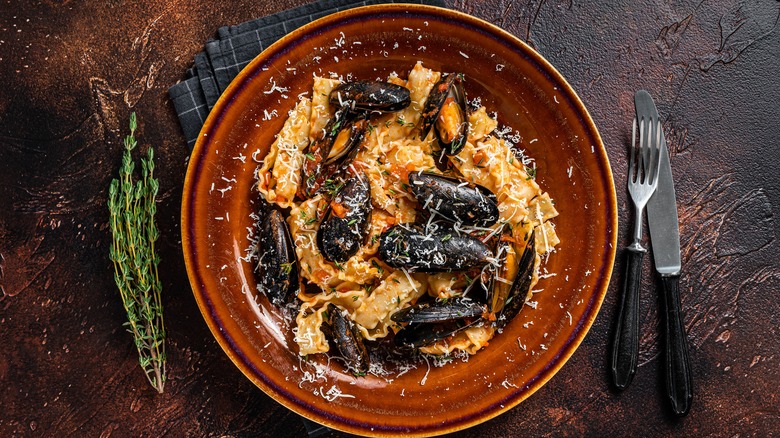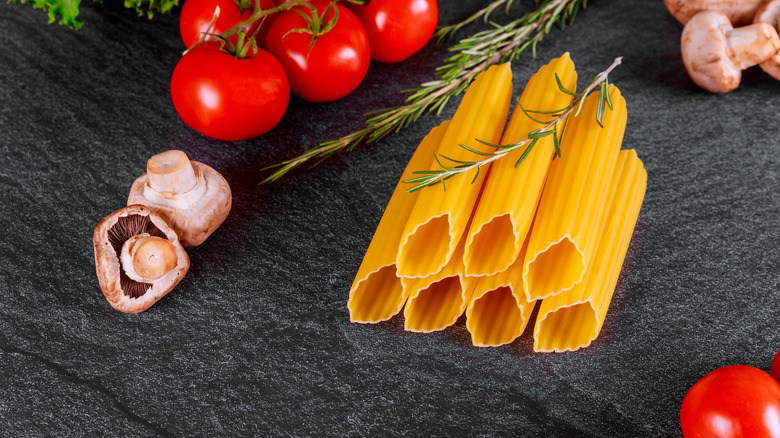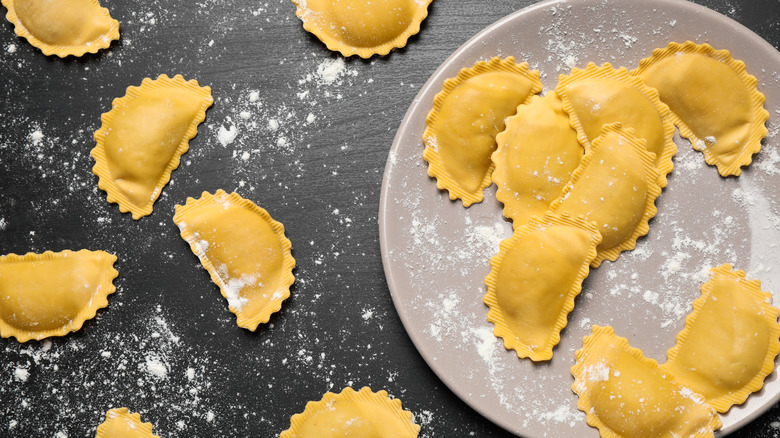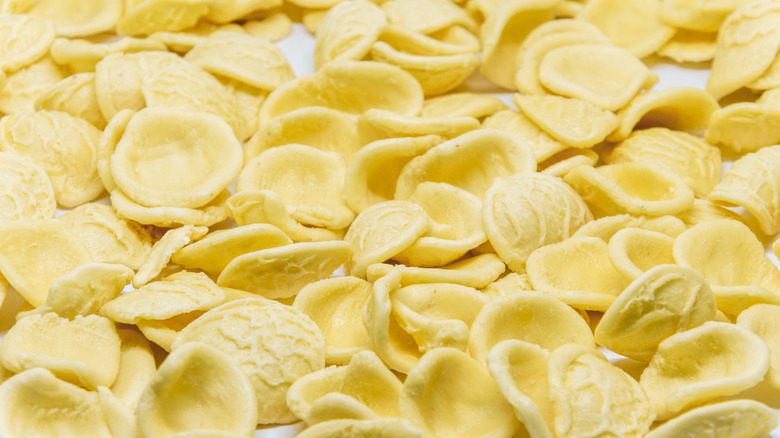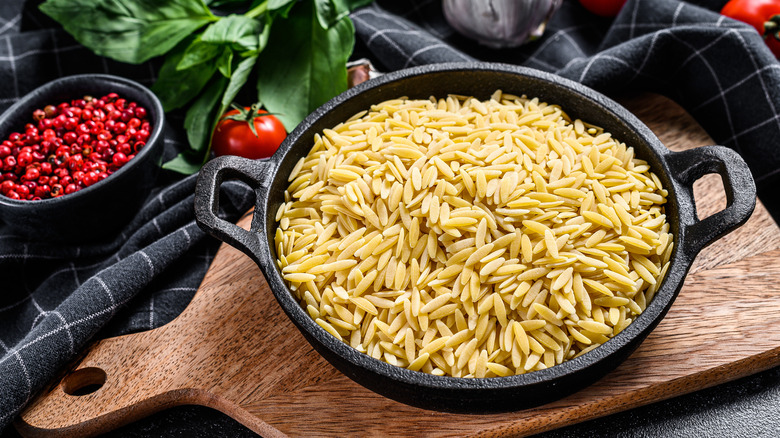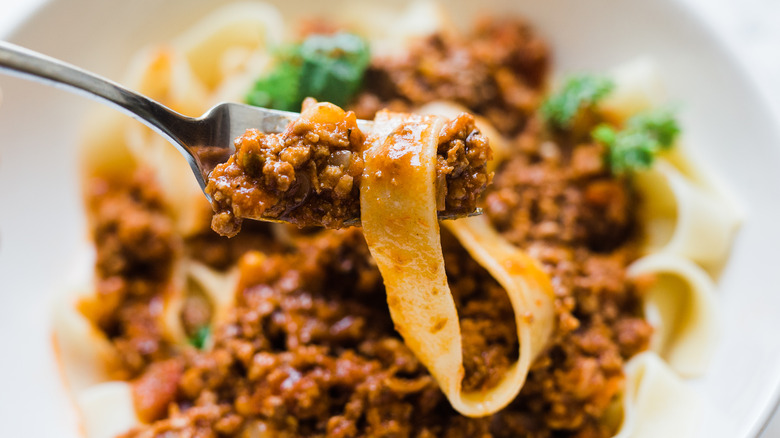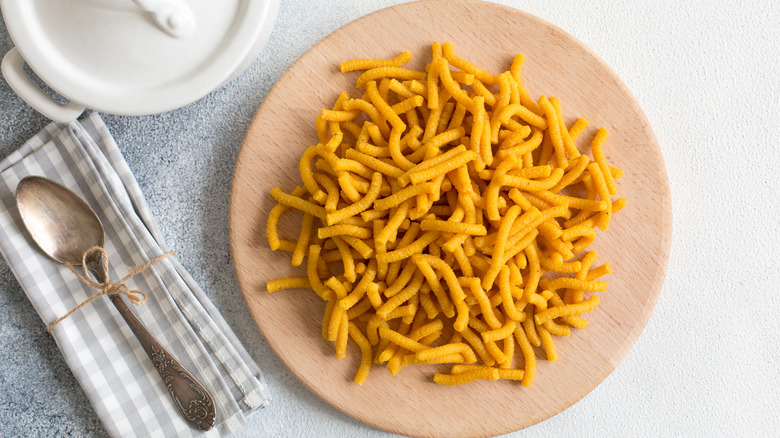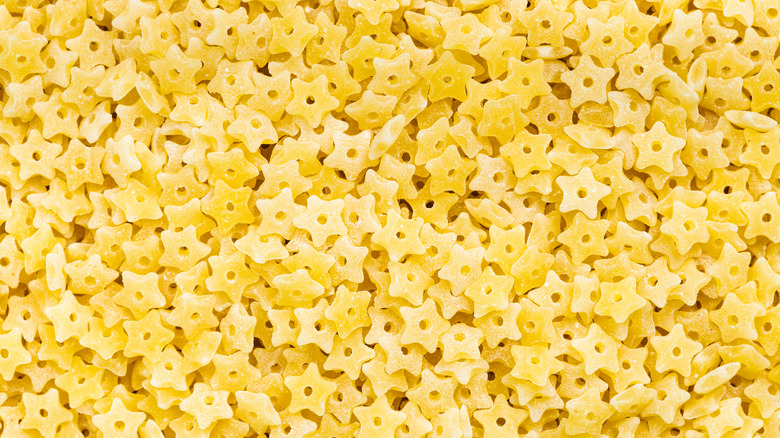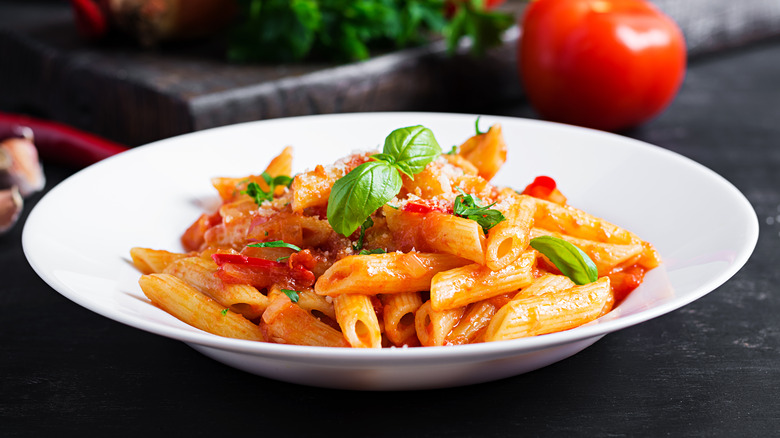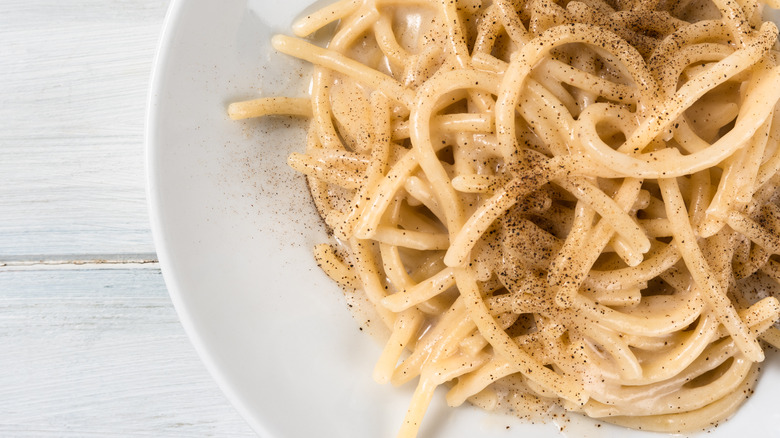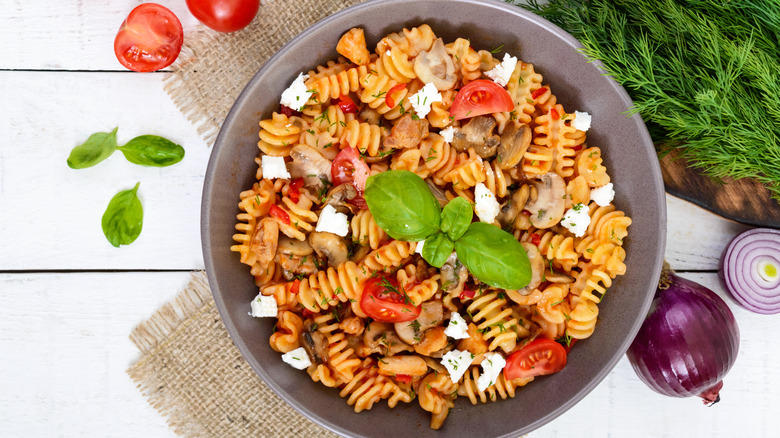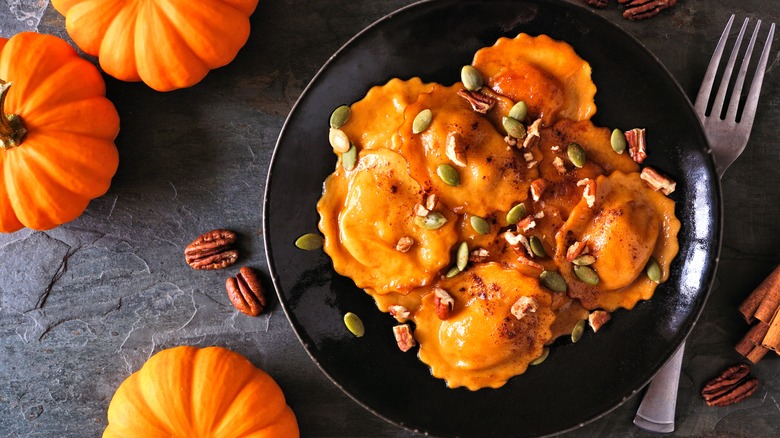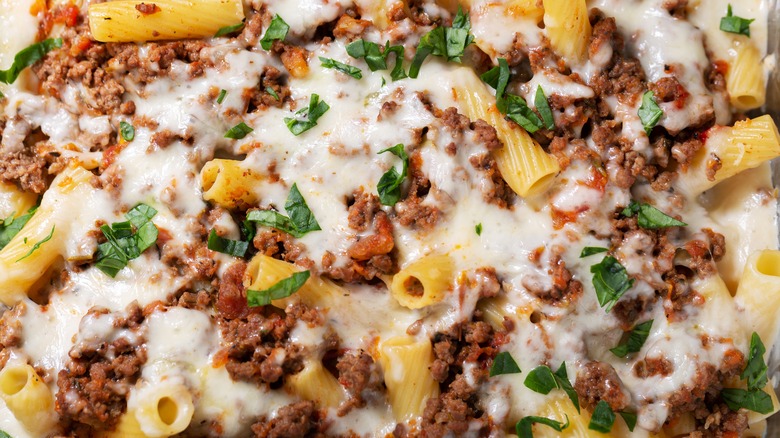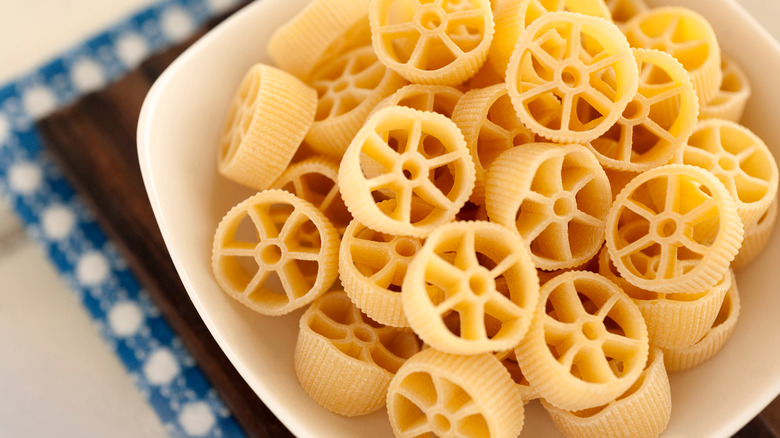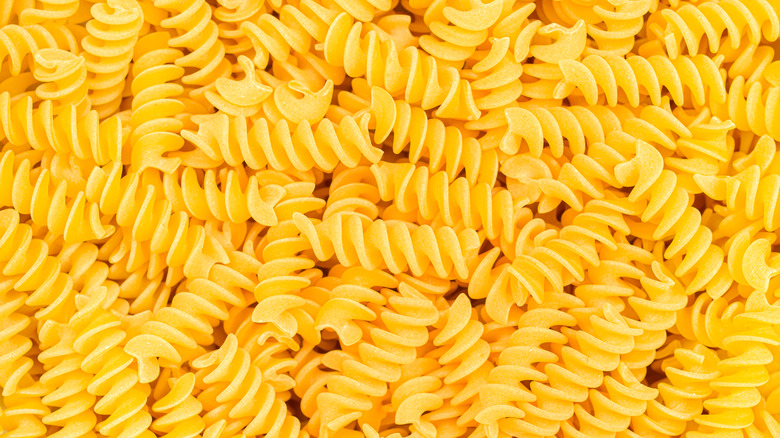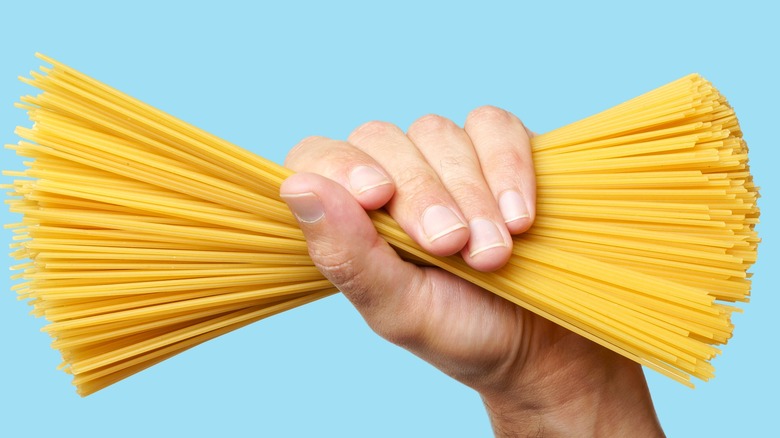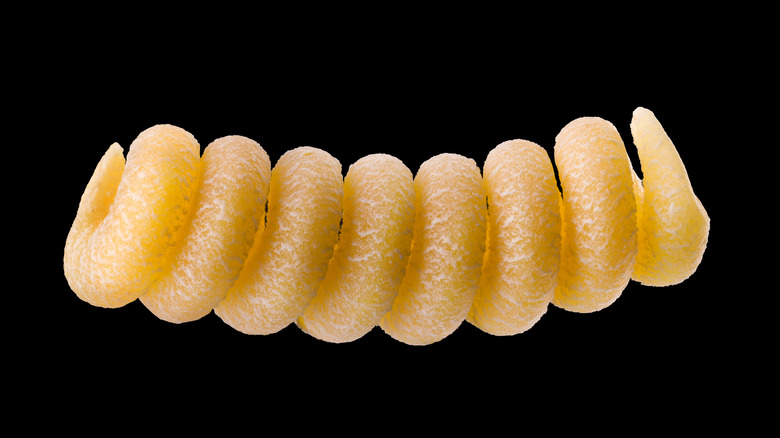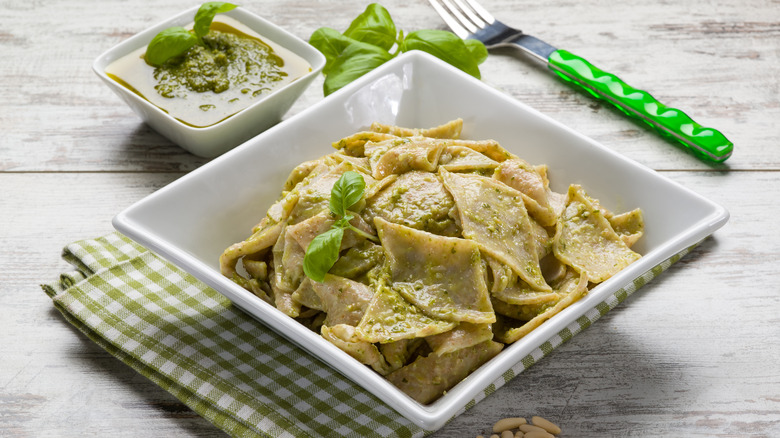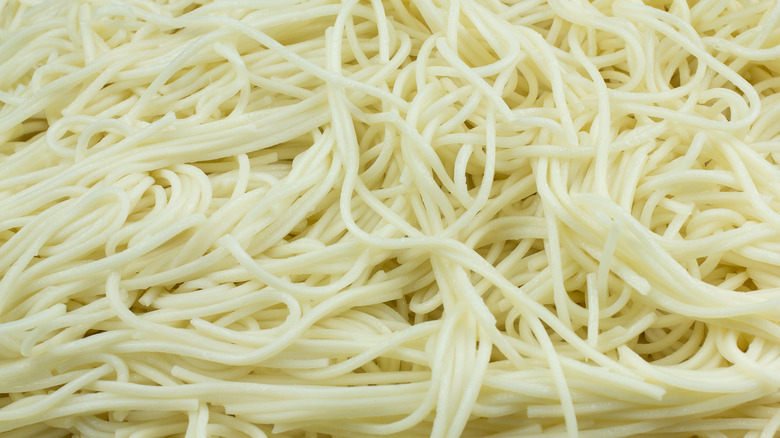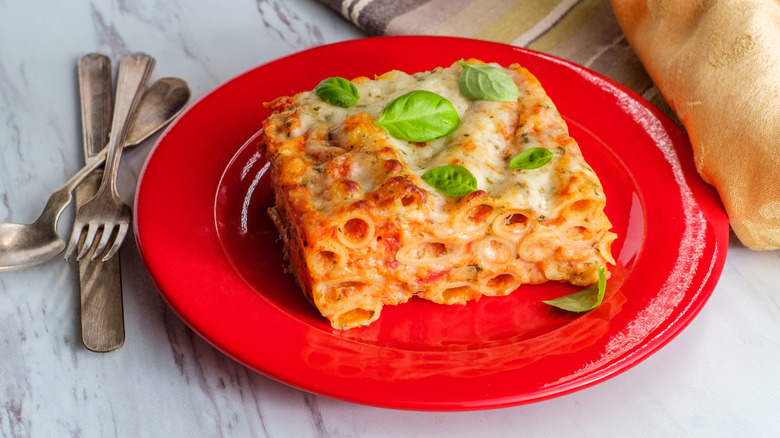44 Types Of Pasta And When You Should Be Using Them
We may receive a commission on purchases made from links.
Now, you could just buy a box of penne pasta, use it for all sorts of quick-fix dinner needs and call it a day. But give this a thought: Penne pasta is but one of more than 300 different types of pasta existing today, shares Food52. Pasta roughly translates to paste in Italian, referring to the mix of flour, water, and/or eggs that pasta is made from. This simple mix of a few ingredients, however, differs greatly through the many regions of Italy, where each region produces its own type of pasta based on what it is meant to be eaten with.
Northern Italy, for example, tends to add eggs in the dough to make a pasta that is elastic enough to hold heavy fillings inside. This is why some of the most popular stuffed pastas come from this region. Tubular kinds of pasta with hollowed centers come from central Italy while thickness and peculiar shapes are characteristics of pastas that come from the south.
The various types of pasta are not just born from the abundance or scarcity of certain ingredients in a particular region of Italy. Each pasta is meant to serve a saucy purpose. Thicker noodles tend to fare better in equally heavy sauces whereas thinner ones are best left to lighter sauces (via Delish). If you want to nail the ratio of pasta to sauce in each bite, it might be a good idea to become familiar with certain types of pasta and when you should be using them. Once you know the trick, using penne for everything will never be the same.
1. Bucatini
A little tweak in a pre-existing pasta can lead to the invention of an entirely new type of pasta. It may seem like an insignificant change, but the bucatini is proof that small differences between various kinds of pasta can change the entire eating experience when used appropriately. Bucatini gets its name from buco, Italian for "a hole" (via The Spruce Eats). Bucatini is essentially like spaghetti except it has an entirely hollowed center.
This hallowed center makes all the difference and Bon Appétit even goes so far as to suggest that bucatini is the best pasta in the world. The site says that while spaghetti only gets coated with sauce from the outside, the hollowed center means that the sauce will also fill inside the bucatini noodles which makes it an ideal pasta for anybody that likes their noodles extra saucy. The thin pocket of sauce inside the noodle also produces a distinct noise when you're slurping away at your pasta, further making it an amusing dining experience.
Bucatini can be served in any sauce that you would otherwise serve spaghetti in. A traditional bucatini preparation calls for an Amatriciana sauce made from guanciale, a type of Italian meat made from pork cheek.
2. Cannelloni
Cannelloni, you could say, are hollow tubes of pasta that you get when thin sheets of lasagne pasta are rolled into cylinders and stuffed with fillings inside. Some historians believe that cannelloni's origin can be traced back to buckwheat crepe which used to be eaten in the Valtellina region of northern Italy (via Tumn). These crepes were stuffed with a filling of a selection of locally produced cheeses, cabbage, and béchamel sauce. Others believe that cannelloni was invented sometime in the first half of the 19th century, in Campania, when a chef named Vincenzo Corrado mentioned a large pacchero (pacchero is a smaller version of a cannelloni) in his cookbook, which he boiled, stuffed with meat and truffles, covered in a meat-based sauce and baked.
Cannelloni is still best prepared in a similar way although the fillings and sauces vary. In Campania, a mix of mozzarella, ricotta, and ham is filled inside cannelloni whereas Roman recipes call for a meat-based filling as well as a meat ragù to drizzle over the pasta. In the Umbria region of Italy, a white cannelloni with béchamel and Parmesan is preferred. A filling of spinach and ricotta with béchamel for tomato sauce and Parmesan is often used when serving cannelloni as a first course in some parts of Italy.
3. Capellini
Capellini, more popularly known as angel hair pasta, is similar to spaghetti except it's about a third of its size (via Delighted Cooking). Capellini translates to hair, which perhaps indicates how soft and thin the pasta really is. Made from a mix of flour, eggs, and water, the delicate pasta is often sold rolled in nests, requires only a small amount of time to cook, and is ideally tossed in very light sauces.
A few years ago, capellini found itself in the middle of a great debate for its tendency to overcook and become mushy and tasteless, reports Taste. Even LeBron James weighed in and said that the pasta had no substance just as rumors were flying that Joe Biden requested angel hair pasta in Pomodoro sauce at various events. Regardless of the side that you're on when it comes to capellini, the pasta is thought to be very easy to digest without much chewing required and so is served in a broth to infants and new mothers alike in Italy. Even Giada De Laurentiis, who found the fragile pasta to be a pain to cook with, found that capellini was thin enough for her daughter to eat without posing a choking hazard.
When paired with fresh flavors and light dressings, capellini can be one of the lightest types of pasta to eat. Light dressings of tomato, herbs, garlic, and oil or butter and cheese can be used to flavor capellini. The noodles can also be served cold in salads or used in stir-fries with thin slices of meat.
4. Caramelle
Even though it sounds like a tasty sweet, this shape is actually a stuffed, savory pasta. It is so named for its visual similarity to a wrapped caramel. The caramelle, according to Geometry of Pasta, is made by filling a tube of pasta dough with a soft filling, such as ricotta, and twisting the ends like a candy wrapper. The delicate egg dough is best when filled with a simple cheese filling or something very soft, like a pea puree.
According to Grub Street, caramelle is making waves in the culinary community and popping up on menus across the country. Because of the typical filling of soft cheese, this pasta can only be handmade, and the fresher, the better. To try this unique shape, you're better off looking for restaurants with skilled Italian chefs making them by hand or trying it yourself. To make them, start with a smaller version of cannelloni, then twist the ends. You could end up with a sweet supper with a bit of practice.
5. Casarecce
Casarecce (which translates to "homemade" in Italian, Taste reports) is a pasta shape characterized by a two-inch long tube shape with a groove down the middle. This shape is made by rolling small sheets of pasta dough into tubes and can be done by hand. Casarecce is excellent for holding on to some of the runnier sauces and is ideal for dishes studded with chunks of meat or vegetables. The spongy pasta tube is easily stabbed with a fork, so you won't find yourself chasing a cherry tomato or piece of sauteed zucchini around the bowl.
Even though the very name casarecce suggests a homemade construction, this shape can be made by machine using an extruder. Many companies sell commercially-available options stateside, so you don't have to learn how to make pasta to try some. According to Taste Atlas, Casarecce originates from Sicily, so try pairing it with some traditional Sicilian flavors, like shrimp or swordfish in a robust tomato sauce.
6. Cavatappi
There are many options for spiral-shaped pasta out there, and one that works great in all dishes is cavatappi. Cavatappi is elbow macaroni's longer cousin. It's made the same way, using a die and an extruding machine, only more of the pasta is allowed through before being cut.
Cavatappi has all the same great qualities as macaroni but with a slightly more exotic flair. This makes it the perfect choice for elevated takes on mac and cheese, like this version with chicken apple sausage and sage. It works as well with thick cheese sauces that can fill the hollow tube as it does provide a springy bite to a fresh pasta salad. Simple is always best, like the super-popular pesto and chicken cavatappi at Noodles and Company. The larger size of cavatappi makes it easier to stab with a fork than macaroni, so it's great for eating on the go.
7. Colonne pompeii
Colonne pompeii sounds more like an architectural term than a pasta shape, but that's just what this noodle is called. It's named colonne pompeii because of its resemblance to the columns of Pompeii. This shape is very similar to fusilli or rotini and is made the same way but simply cut longer. Colonne pompeii combines the fork-twirling fun of linguine or tagliatelle with the enjoyable mouthfeel of fusilli.
Colonne pompeii had a few viral Instagram moments on social media recently and has since become more widely available in stores across America. However, if you want to get your hands on some, you'll probably still have to track them down from a specialty artisan pasta maker. You can pair it with any sauce you'd use for strand pasta or short curly pasta. Tomato sauces, thick, cheesy sauces, or a combination of the two (like vodka sauce) will all work well with colonne pompeii.
8. Conchiglie
Conchiglie more commonly goes by the name of shell pasta because of its distinct sea shell-like shape (via Delighted Cooking). Conchiglie is usually made from hard durum wheat which allows the pasta to hold its shape even when it is boiled and baked. The shell-like shape of conchiglie means that the pasta has a narrow cavity on one side that can trap chunky meats and vegetables inside. When flipped, the pasta has a ridged surface and so can hold all sorts of thin or thick and chunky sauces.
Smaller varieties of conchiglie known as conchigliette can be added to soups or used in place of elbow pasta in mac n' cheese. The large variety known as conchiglioni are oversized jumbo shells that can be great vehicles to hold fillings inside and baked. Alternatively, conchiglie can be enjoyed in a quick olive oil and herb dressing, especially if you're using red and green colored conchiglie that have a sun-dried tomato or spinach flavoring.
9. Ditalini
There's a whole world of smaller pasta shapes designed for dishes best eaten by the spoonful. Ditalini may be one of the most famous for its use in the classic Italian soup, Pasta e Fagioli. Sometimes called tubettini, ditalini is a shorter version of macaroni and can be made likewise using a pasta extruder. The exterior can be smooth or ridged and technically falls under the "pastina" family of pasta shapes for its small size.
GourmetSleuth reports that ditalini — which translates to "little thimbles"— is too short to hold on to much of anything for very long. This shape in a soup works because it's small enough to fit on a spoon and any broth. Ditalini is also sometimes used in minestrone. If you want to use this shape for something outside the world of soups and stews, try pairing it with similarly shaped foods, like peas or finely chopped pancetta.
10. Egg Noodles
The term "egg noodles" can be misleading, as it doesn't necessarily refer to pasta. Many kinds of pasta are made with eggs and thus egg noodles, and many types of egg-based noodles exist that wouldn't be considered Italian pasta. Most often, in America, you will see egg noodles near pasta or other ethnic foods to be used for such non-Italian dishes as matzo ball soup, beef stroganoff, or casserole. Technically speaking, chow mein noodles are also considered egg noodles as they are made with wheat flour and egg.
This kind of noodle can be used as pasta in a pinch, but if you're making Italian, you should still cook your pasta to "al dente," meaning it still has a little bite. This shape will work with any sauce, from tomato to alfredo. The shape isn't designed to cling to any particular sauce or provide any special mouthfeel but works well as a base for more complex dishes.
11. Elbows
You may know this ubiquitous pasta shape as "elbows," but the Italians know it by a different name: macaroni, or maccheroni. Of all the pasta shapes, macaroni might have one of the richest histories. Of course, in America it is most known for its starring role in macaroni and cheese (to the point that some might start looking for alternatives). The popularization of macaroni and cheese in the U.S. is credited to Thomas Jefferson, who reportedly served it at a state dinner after trying the dish abroad and bringing it home (via Escoffier Online).
While macaroni often refers to this particular shape (a short, curved, hollow tube), it may also refer to all dried pasta as a whole. Some say that macaroni pre-dates Italy and could refer to the noodles that Marco Polo first brought back from China in the twelfth century (via Clifford A. Wright). Whatever its origin, macaroni is ideal for pairing with thick, cheese-based sauces that fill up the tube and cling to the ridged exterior.
12. Farfalle
Farfalle pasta gets its name from the word farfalla, Italian for butterflies (via Delighted Cooking). Thanks to its unique shape that resembles butterflies and bow ties, the pasta also often goes by another popular name — bow tie pasta. Farfalle originated in the Lombardy and Emilia-Romagna regions of northern Italy that are famous for making pastas with fillings inside (via Food52). Consequently, it is said that farfalle was an accidental by-product of a filled pasta. Per The Pasta Project, sixth-century housewives used to make stuffed pastas and whenever they ran out of filling, they turned the leftover dough into butterfly-shaped farfalle, also known as strichetti in the region. Because of the fun shape, the leftover dough pasta became so popular that it turned into a rightful type of pasta in itself.
Made from durum wheat, farfalle tends to hold its shape particularly well and so is a good pasta option for baked casseroles as well as for creamy tomato and cream-based dishes. Farfalle can also be a fun addition to otherwise boring salads!
13. Fettuccine
You could divide pasta into two broad categories of long and short. While the shorter varieties — penne, fusilli, farfalle, and the likes — are easier to distinguish from each other, the long varieties of pasta are where things often get confusing. Fettuccine is a long pasta that is cut into thick ribbons with a width that stands somewhere between linguine and tagliatelle.
Translating to little ribbons in Italian, that's exactly what fettuccine looks like (via Delighted Cooking). Fresh fettuccine pasta is usually made from eggs and flour and so has a noticeably eggy taste. Some fettuccine makers cut their ribbons long enough for a single strand to fill an entire forkful. Fettuccine can hold its shape in all sorts of cream and tomato sauces, as long as it isn't being served in a chunky sauce. Famously served with Alfredo, fettuccine is a no-brainer if you're craving pasta covered in a creamy white sauce.
That being said, Fettuccine Alfredo seems to be a saucy, heavy cream-based pasta of American origin because no such dish exists in Italy (via HuffPost). Italians do serve a version wherein fettuccine is tossed in a generous dollop of butter with a heap of fresh Parmigiano-Reggiano — a simple pasta dish often served to anybody with an upset tummy.
14. Fileja
The south of Italy is famous for giving its pasta peculiar shapes — take the orecchiette, shaped after the human ear, for example. Fileja comes from the southern Calabria region of Italy and has a swirly shape which makes the pasta look like an elongated screw (via The Pasta Project). About three to four millimeters in thickness, fileja is almost always made fresh and at home, rather than bought in a dried form from a store.
To make fileja, a dough of wheat flour, salt, and water is rolled into strings of small ropes that are no longer than three inches in length. The rope of dough is then pressed onto a small metal stick traditionally called danaco or dinacolo, which is rolled a couple of times till the fileja gets its shape. The stick is removed from the dough and the fileja is then tossed in a sauce. In Calabria, fileja is typically eaten on Sundays and holidays, soaking in a sauce of tomatoes or minced pork. When rolled fresh, fileja also goes well with meaty, heavy, and spicy sauces, especially those made with a spicy 'Nduja sausage from Calabria.
15. Fusilli
Fusilli gets its shape from a particular method of spinning strips of pasta on a spindle rod till they turn spiral (via The Spruce Eats). Due to the comparatively tricky method of making fusilli, it can be a difficult pasta to make at home. However, the key to fusilli is precisely in its method where the spiral creates hollow gaps in the surface of the pasta. This makes it a particularly good type of pasta to choose when you want the pasta to really hold in the sauce in each bite — anything from chunky, meaty sauces, to light vinaigrettes in a pasta salad. Delighted Cooking also notes that because most store-bought fusilli are made from hard durum wheat, they tend to hold their shape well even when reheated after refrigeration. You might want to swap out other pastas for fusilli if you're making pasta meal preps weeks in advance and don't want your pasta to become mushy when reheated.
While the traditional fusilli is essentially a strip of dough in a twisted form, there also exists a variety of fusilli called fusilli bucati wherein the spiral pasta has a hollowed center. Fusilli lunghi on the other hand, is like normal fusilli except in a longer, ribbon-like form.
16. Garganelli
Even though garganelli may look a lot like penne (via The Pasta Project), it's an ancient pasta shape that all mechanical pasta manufacturing. While penne is made by being forced through a metal die, garganelli starts as square sheets of pasta rolled around a dowel or wooden stick and pressed closed. As the story goes, a cardinal in the seventeenth century hired a chef for a dinner party who ran out of filling for his cappelletti. So he rolled his pasta sheets around a wooden spoon, and garganelli was born.
This pasta shape is made with a softer egg dough, as opposed to the semolina and water dough used for shapes like macaroni and fusilli. Traditionally, garganelli is best when paired with meat sauces, either a ragu or with some kind of pancetta or sausage. In addition, small foods like peas will find their way into the tube for a pleasant eating experience.
17. Gemelli
Gemelli is named after the Italian word for twins because of its appearance which looks like two separate strings of pasta that are intertwined together into one piece of pasta (via Delighted Cooking). On the contrary, however, gemelli is made out of a single piece of pasta that is given a twisted shape.
According to Instacart's grocery trends report for 2021, gemelli pasta saw a 457% increase in popularity last year. Part of the pasta's popularity can perhaps be credited to its versatility. Much like penne, gemelli can be used in all sorts of sauces and cooking preparations. The small crevices on the surface, created from the twisted shape of the pasta, mean that gemelli can trap all kinds of sauces well. You could use it in tomato-based sauces, cream-based ones, or even meaty sauces. Gemelli also goes well with pesto and oil-based dressings and can be used in casseroles, cold salads, or even in soups.
18. Gigli
Gigli pasta also goes by the name of campanelle, which translates to bellflowers or little bells, the objects that the pasta is shaped after (via The Pasta Project). Although some dispute gigli's origin, it is widely believed that the pasta comes from Tuscany and is inspired by the lily flower that is the national emblem of Florence. This is why gigli often goes by the name of gigli Toscani in the region.
Fresh gigli is typically made from a dough of semolina, eggs, and salt, which is then shaped like a bell with ruffled edges (via Foods Guy). Because of its unique shape, gigli has a deep cavity on one side just as a bell does, which can hold sauce inside it. In Tuscany, gigli is usually served in a venison ragù due to the penchant for game meat in the region. The pasta does go well with cream- and vegetable-based sauces too. Another popular dish called pasta tordellata combines a mixture of ricotta and Swiss chard that is stuffed inside the tiny cavity of gigli, which is then covered in a meat ragù.
19. Gnocchi
Gnocchi is different from some of the other types of pasta on this list as they are not a noodle or a stuffed pasta but rather a dumpling. Gnocchi is made using cooked potato and if made right, hearty enough to sear to a crisp yet light enough to dissolve in your mouth. This dough also calls for flour and egg in just the right balance, though you can also use ricotta cheese to bind instead of the egg. One key factor in nailing the texture of gnocchi is not to add too much liquid to the dough. Celebrity chef Nigella Lawson opts for baking the potatoes instead of boiling them not to add any extra moisture to the dough.
If you opt for store-bought gnocchi, there might be one big mistake you're making. The texture will be different, so consider skipping boiling the gnocchi altogether and just sauteing or roasting them.
20. Lasagne
While lasagna — the singular of lasagne — refers to the saucy baked dish with layers of pasta sheets, cheese, meat, and vegetable, lasagne is the name of the thin pasta sheets that are used in its making (via The Pasta Project). The first signs of the lasagna as we know it dates back to the 1800s when tomatoes became popular in Italy, but some believe that a baked dish of "lasana" or "lasanum" was eaten by the ancient Romans, making lasagne one of the oldest types of pasta that exists.
In northern Italy, lasagne sheets are made from eggs and are layered with bolognese and béchamel sauces with Parmigiano-Reggiano on top. In the south, lasagne sheets are often made without the eggs whereas in Campania, the sheets tend to be layered with meatballs, ragù, ricotta, pecorino, and provola cheese. In some areas, lasagne sheets are layered with a meatless, vegetable-based ragù and in others, the ragù is skipped for pesto sauce. Some regions also make a white version of the lasagna which skips the use of tomato altogether.
Alternatively, sometimes lasagne sheets can be rolled into cylindrical tubes of cannelloni or manicotti pasta when in a pinch. There also exists a thinner variety of lasagne sheets with wavy edges called lasagnette (via Delighted Cooking). Lasagnette is often used in place of lasagne to make a smaller and narrower version of lasagna.
21. Linguine
From the same family of long noodle pastas as spaghetti and fettuccine, linguine could be thought of as a flattened version of spaghetti (via The Pasta Project). Meaning "little tongues" in Italian, linguine is usually made from a dough of durum wheat and water. Unlike fettuccine that pairs well with thick sauces, or the more delicate spaghetti that needs smooth and light sauces, linguine is best served in cream-based sauces.
Linguine comes from the northwestern region of Liguria in Italy where the pasta is tossed in green pesto Genovese with potatoes and beans, but it is also one of the few kinds of pasta that is famously served alongside seafood in various coastal regions of the country. While other noodle pastas are best served with meat, linguine can be prepared with clams, mussels, prawns, calamari, and all sorts of seafood. In Tuscany, linguine is served with shrimp and tomatoes; a mix of creamed salmon, mussels, and pumpkin is preferred for linguine in Lazio; and Sardinia serves linguine with either crayfish or lobster. Regardless of whether you're cooking linguine with pesto or seafood, the pasta is rarely ever served in a heavy sauce with meat.
22. Mafaldine
Some say that mafaldine was invented by the people of Naples to welcome the king of Sicily and his family when they moved the court to Naples in 1258, according to Pasta Nostra. The pasta was so loved by the king that it gained a firm place in the culinary history of Naples. Others suggest that a certain manfredine pasta already existed in Naples when it was renamed to mafaldine to mark the birth of Mafalda, the second daughter of the Italian king, Victor Emmanuel III (via The Pasta Project). Consequently, mafaldine is also known as reginette or little queens.
Mafaldine is a long string of flat pasta with ruffled edges and is made from durum wheat semolina. In Naples, mafaldine is usually served in simple sauces like ones made from lard, ricotta, and pecorino cheese, or served alongside winter vegetables like artichokes. In Puglia, a dish called la barba di San Giuseppe is cooked on St Joseph's day (the same day as Father's Day), where mafaldine pasta is supposed to represent St Joseph's beard.
23. Manicotti
Manicotti is similar to cannelloni in that both are large, hollow tubes of pasta meant to be stuffed with cheese or other fillings (via The Pasta Project). Manicotti, loosely meaning "little sleeves," according to Share the Pasta, are typically found ridged, whereas cannelloni is not. In America, manicotti is often prepared in a classic recipe similar to lasagna. It starts by stuffing the pre-cooked manicotti with a seasoned ricotta cheese mixture and then layering it with tomato sauce and mozzarella cheese before being baked in the oven.
Unlike its smooth-sided cousin cannelloni, manicotti can't be made by hand and is made like other tube-shaped pasta using a pasta extruder. Due to the tube size, even a thick sauce is unlikely to stay inside. For experimenting beyond the classic manicotti recipe, you're better off making a hearty filling of cheese, meat, vegetables, eggs, or a combination, then adding a sauce to the top. Think of this shape as an open-ended ravioli.
24. Mezzelune
Ravioli isn't the only stuffed pasta out there. Originating from Northern Italy, mezzelune gets its name from its shape, a "half moon." This shape may even pre-date the ravioli and shares many similarities with other types of dumplings from both near and far. Mezzelune comes from a northern region of Italy that neighbors Austria, and just across the border, they have another name for this shape: schlutzkrapfen.
The effects of food and trade can easily be seen worldwide, and mezzelune is the perfect example of how varying dishes can appear in different parts of the world and are beloved by a variety of cultures. From Polish pierogies to Chinese wontons, many cultures worldwide have taken a circle of dough, stuffing it, then folding it in half and crimping the edge. Unlike ravioli, which are often made using a mold or a specialized stamp, these can be made freehand and use only a drinking glass as a cutter.
25. Orecchiette
Orecchiette pasta is extremely easy to spot in a supermarket aisle filled with rows of pasta boxes. Shaped like little ears, Orecchiette comes from the word Orecchie, Italian for ears (via Italy Bite). Of the many theories around the origin of orecchiette pasta, some say that the pasta is a culinary invention made by the Jews who had settled close to Bari in southern Italy. This is because of the similarity between the appearance of orecchiette and the Jewish dessert hamantash, also known as Haman's ears.
Regardless of its origin, making orecchiette pasta requires skill and patience as each pasta needs to be rolled out one by one, and then needs the application of gentle pressure by hand to give it its ear-like shape. The outer surface of the pasta should have a rough texture so that it can hold the sauce and each orecchiette should be no bigger than the tip of the pinkie finger. Traditionally, orecchiette is served with turnip greens and used to be known as Sunday pasta as it was meant to be eaten on special occasions. Now, orecchiette is often served alongside all sorts of greens and vegetables, including broccoli. Its concave shape also makes orecchiette an excellent choice for anybody who likes their pasta extra saucy as the little wells hold lots of sauce in each bite (via Tumn).
26. Orzo
To the untrained eye, orzo may look like an unusual type of rice. Even more confusing, orzo in Italian translates to barley (via Eat This, Not That). Upon looking closer, you'll notice that orzo has the texture of pasta and in reality, is made out of semolina flour. Orzo is a type of pastina — a category of pasta that is very small in size.
This pasta, however, is widely used even outside of Italy with various dishes in Greek, Mediterranean, and Middle Eastern cuisines, depending on the use of orzo. Chicken and orzo, in particular, is a popular soup. Orzo is unique in that it tends to absorb other flavors very well and cooks quickly. Orzo is also often used like rice in pilafs, can be added to baked casseroles, or used as stuffing in dishes where you would otherwise use rice (via Delighted Cooking). The pasta can be tossed in butter and used as a base for salads or used in soupy and heavy sauces with pieces of meat. Because orzo pasta is made from hard durum wheat, it can hold its shape well even when cooked for a comparatively long time in dishes like soups and stews.
27. Paccheri
According to popular legend, the government of Prussia — modern-day Austria — had once banned the trade of Italian garlic between Italy and Prussia (via Delighted Cooking). Italian farmers who thought that Prussia's garlic was nowhere near as flavorful as Italian garlic, found a way to smuggle Italian garlic with them when they were crossing borders. To do so, they created a pasta that was shorter in size than a rigatoni but with a larger diameter in which at least four garlic cloves could be squeezed in and smuggled!
Fitting of its legend, paccheri pasta tends to be cooked in sauces that are extra garlicky and are often served tossed in a red wine sauce with a stuffing of garlic and sausage. Seafood — lobster, octopus, and shrimp in particular — too is a popular choice of filling for paccheri. Alternatively, because of its tubed shape and hollowed center, paccheri is also an excellent pasta for chunky meat and vegetable sauces as well as ragù and bolognese. The pasta can be stuffed with ricotta and served as a baked lasagne of sorts with layers of cheese and sauce. Oftentimes, paccheri is also served as a first course with zucchini, squash, and cabbage.
28. Pappardelle
Pappardelle is an egg-based pasta that is cut into long ribbons. Simply put, if a tagliatelle pasta was to be cut wider, it would be pappardelle — one of the widest pasta of the existing long-ribbon pastas (via Pasta Evangelists). Pappardelle's origin can be traced back to 14th century Tuscany, a region of Italy famous for rich and meaty sauces that are cooked during winters or on feasting days. Needless to say, pappardelle was a pasta fashioned to be able to carry meaty Tuscan sauces with equal weight.
Pappardelle gets its name from the word pappare, which means, to gobble up. The pasta used to be rolled out from a dough made of chestnut flour, but now, a combination of flour and eggs is typically used, shares The Pasta Project. Pappardelle is cooked more often during the months of winter which is the main hunting season in Italy. Game meat — usually wild boar, birds, and hare — is used to make a rich ragù which is then eaten with pappardelle. When game meat is not an option, it can be substituted with an equally rich meat like pork, beef, or duck in a ragù. For a vegetarian option, mushrooms with a meaty texture are a fine substitute, as the key to a pappardelle pasta dish is to use a rich, heavy, and meaty sauce.
29. Passatelli
Whether or not passatelli should be called a pasta or not is a matter of debate between chefs. While it is technically classified as a type of pasta, InsideHook explains passatelli is one of the very few kinds of pasta that are made without any flour. Instead, passatelli is made from a mix of eggs, Parmigiano Reggiano cheese, and stale breadcrumbs. A type of pasta from the Emilia Romagna region of northern Italy, passatelli was born out of the same need to use leftover ingredients as pici (via The Pasta Project). Although the ratio of breadcrumbs and cheese should be equal, in older times, rich households in Italy would add more cheese than breadcrumbs, and the poor added more bread than cheese.
Passatelli translates to "passing through," referring to the way in which the pasta dough is passed through a press like a potato ricer with multiple holes in it to get tiny noodles. Because of the amount of bread and cheese used, passatelli is a very heavy and cheesy pasta in itself that is best eaten in a light broth. The use of Parmigiano Reggiano makes it a nutritious meal for anybody under the weather and its easy digestibility is thought to make passatelli an ideal meal after giving birth, says Recipes from Italy. Since the pasta is equal parts bread, it also absorbs liquids easily and so, makes for a very heavy and filling meal.
30. Pastina
Pastina is a group of small-sized pastas that are often served to children in Italy (via The Spruce Eats). There is no particular shape that a pastina pasta must have and so, all sorts of small-sized pastas can be considered "pastina." As long as a pasta is smaller than a quarter-inch in size, it can fall into this pasta group. Orzo is a type of pastina and so is the star-shaped pasta made from durum wheat that Barilla sells as "pastina," which the pasta maker says is a fun pasta through which children can be introduced to the world of saucy, cheesy goodness.
Pastina can be used in place of croutons in tomato soup but really, are a great addition to all sorts of soups and broths. Certain kinds of pastina such as orzo can be used in pilaf as an alternative for rice, and other shapes can be tossed in some butter and Parmesan and served as a side dish or topped onto salads.
31. Penne
When COVID-19 was officially classified as a pandemic and countries across the globe were bracing for a lockdown, each country dealt with the news in its own way. While most were hit with a toilet paper crisis, Italy was facing a severe pasta shortage. No matter how empty the pasta racks were at Italian supermarkets, Taste reports that there was always plenty of penne lisce on the shelves — a smoother ridgeless cousin of penne rigate. Italians, it turned out, preferred eating no pasta at all than eating a bite of penne lisce.
Penne rigate is the variety of penne pasta that we're most familiar with, rigate referring to the ridged surface on the penne pasta (via The Pasta Project). Penne pasta looks similar to the tip of a quill and so, is named as pen aka penne in Italian. Penne was invented on March 11, 1865, when Giovanni Battista Capurro managed to patent a machine that could cut pasta diagonally (without the pasta breaking), a task previously done by hand. Today, penne is best served with meaty sauces that stick well inside the hollow tubes of penne or rich tomato sauces like the spicy arrabbiata that coat evenly onto the pasta's ridges.
32. Pici
If you've ever eaten cacio e pepe, you will have noticed the noodles that look a lot like long strands of spaghetti but are somehow, slightly different. Famously served in cacio e pepe, the noodles are pici. Tuscan in origin, pici embodies the pheasant cuisine of Tuscany wherein leftover ingredients are used to cook new dishes (via Italy Bite). This is why, although you'll find store-bought pici with eggs, traditional Tuscan pici is only made with flour, water, and salt, as eggs were too precious to be added to noodles made from leftovers. Theories suggest that a noodle that existed during the times of the Etruscan in 473 BC possibly have been pici.
Per the Tuscan method, each pici noodle is rolled out by hand, cut into strips, and then hand-rolled again till it's thicker and tougher than a spaghetti in that it can carry thick and hearty sauces characteristic of the Tuscan cuisine. Because pici pasta was prepared as a meager meal of leftovers, it is often served with oil, crumbs of stale bread, and the odd chili pepper. A sauce made from the Tuscan garlic Aglione is also often served with pici. The hand-rolled noodle can also carry rich ragù and mushroom-based sauces or, there's always cacio e pepe.
33. Radiatori
While some pasta shapes date back centuries, others are relatively new to the world. Radiatori, so named for their visual similarity to a car's radiator, are only as old as the car itself (Mashed reports that sources differ on the exact decade). It's no secret that the Italians love their cars, and rumor has it this pasta was shaped after a particular car's radiator: that of the Bugatti. Radiatori is a special shape that is unique in the pasta world and must be made via machine. The unique ridges and tunnel hold on to even the thinnest of sauces and make for a highly pleasing mouthfeel.
When it comes to cooking with radiatori, it's best to pair them with ingredients of similar size and shape. Think cherry tomatoes and cubes of zucchini or eggplant. This shape even works for dishes with just sauce and no ingredients, like macaroni and cheese or olive oil and herbs.
34. Ravioli
Of all the 300 types of pasta that exist, ravioli is the one that is most often served at family celebrations, including Christmas, shared The Culture Trip. While the stuffed pasta itself has an important place on the dinner table, it is also the making of the little parcels with family that is an important part of the celebration. Typically, ravioli is made from an egg pasta dough that is cut into squares, stuffed with a filling of ricotta, meat, and vegetables, and sealed.
In northwestern parts of Italy, ravioli most often has a meat filling and is served in ragù with Parmesan on top. These fillings, however, vary from region to region and depend on the occasion that the ravioli is supposed to be eaten for. In southern Italy, meat is replaced with grouper fish and mint, and ragù is swapped for a simple tomato sauce. On occasions such as Christmas Eve when the consumption of meat is forbidden, ravioli is made with vegetarian fillings such as spinach and ricotta and served in a butter, sage, and Parmesan sauce. Traditional celebratory fillings also include pumpkin and almond biscuit (amaretti) stuffed ravioli. In general, ravioli is best served in a sauce where the filling can shine and so, is best tossed in light tomato sauces or a buttery sage sauce (via Pasta Evangelists).
35. Rigatoni
Much like penne, rigatoni too is a cylindrical type of tubed pasta with a hollowed center. While penne is much smaller in comparison, according to Paesana, you could say that rigatoni is the bigger, broader cousin of the former. Similar to penne rigate, rigatoni has ridges and gets its name from rigato, Italian for ridged or lined, but it does not have the pointy quilled shape of penne.
Rigatoni comes from central and southern Italy and is preferred for the deep cavity that the pasta has (via Delighted Cooking). Because of its breadth and size, rigatoni can encase all sorts of fillings inside its tube. You could always toss rigatoni in a simple tomato and meat sauce; however, to make the most of rigatoni, it is best used in baked pasta dishes. Not only will the pasta hold meat, cheese, and sauce inside its cavity well, but rigatoni's size and ridged texture also means that it will hold its shape when baked without becoming too soft and mushy — even when it is covered in a thick layer of mozzarella cheese.
36. Rotelle
Star-shaped pastina, slurpy bucatini, and conchiglie shaped like seashells are all playful kinds of pasta to introduce to kids or make plain ol' midweek dinners a touch more fun. Another fun pasta is the wagon wheel-shaped rotelle (via wisegeek). Italian for little wheels, rotelle pasta can also be found labeled as wheel pasta. No bigger than the size of an American quarter, rotelle is one pasta that does not seem to be Italian in origin.
Although typically made with durum wheat, varieties of rotelle made with quinoa, semolina, or whole wheat are also widely available. The ridged surface on the outside of the wheel and the spokes that create little gaps inside, make the pasta excellent for trapping chunks of meat or vegetables inside it. Rotelle can be served in tomato or thick and heavy cream-based sauces. The pasta also does well in hot soups and cold salads or, can be served on the side when tossed in some oil and Parmesan cheese.
37. Rotini
Rotini is a short, corkscrew-shaped pasta from Northern Italy and is very similar to its cousin, fusilli. The difference between the two is the tightness of the corkscrew. Both types are made by pushing a semolina-based dough through the metal die of an extruding machine. The ridges are perfect for clinging to all-thickness sauces, whether a creamy sundried tomato or a lighter, olive oil-based sauce like this pasta primavera. This versatile shape even works in soups and can be an excellent option for chicken noodles.
Rotini can often be found in a tricolor variation as a fun alternative. It's a mix of the regular, semolina-based dough, some with spinach powder added (turning it green), and some with red pepper or tomato powder added (turning it red). This shape is a huge hit with kids, and the tricolor version can be a great way to add vegetables to their diet.
38. Spaghetti
Some believe that spaghetti (and with it, pasta in general) was introduced to Italy when the famed traveler Marco Polo found a version of the long string-like noodle on his travels to China (via Tumn). However, others believe that a variant of spaghetti made from rice — vermicelli — already existed in Pakistan where it was considered to be the waste from actual pasta prepared for the sultan. Durum wheat from which spaghetti is made was also found to have already been used in Arab countries, especially in couscous.
Despite its contentious origin, spaghetti now happens to be one of the most popular pastas in the world. In ancient Naples, spaghetti was loved by the poor and the nobility alike, with even the king of Naples, King Ferdinand IV, having a particular fondness for the noodle. In fact, back in 2000, supermarkets in the U.S. are said to have collectively sold enough spaghetti to circle the world nine times over (via Mi'talia Kitchen).
Spaghetti's popularity could be credited to its shape that is neither too thin nor too thick and its texture, which is a balance between light and heavy. This makes spaghetti the ideal pasta for all sorts of olive oil-based sauces. In 1844, a time when tomatoes in Italy were becoming popular as an excellent pairing for pasta, spaghetti with San Marzano tomato sauce was invented (via Authentica World Cuisine). Since then, spaghetti has been found to lend well with tomato sauces mixed in with meatballs or vegetables.
39. Spiralini
Another variation in the short, corkscrew-type pasta is the spiralini. This shape isn't a solid piece like fusilli or rotini but is more like a strand of spaghetti or bucatini wound tightly like a pig's tail. In other words, this shape could theoretically be stretched back into a straight strand instead of fusilli or rotini, which are fused in the center. This fun shape is sometimes referred to or sold as fusilli bucati corti (via Amazon).
Like the other spiral and short pasta, this shape is easy to spear with a fork and is best when paired with chunks of meat or cubes of vegetables. The center of the spiral is perfectly shaped, holding thicker tomato or cheese sauces. Pasta sauces like puttanesca would also work well with spiralini because the shape can grab onto the bits of caper and anchovy for bursts of salty flavor in each bite.
40. Tagliatelle
The specifications of tagliatelle are very precise: cut the ribbons of pasta too narrow and you'll have fettuccine but cut them too wide and you'll have pappardelle. The sweet spot in between is tagliatelle (via The Pasta Project). Tagliatelle is an egg pasta that comes from northern Italy which is traditionally rolled out by hand and eaten fresh. Although machine-made durum wheat alternatives are now widely available, handmade tagliatelle used to be rolled out on a wooden surface with a wooden rolling pin (via La Cucina Italiana). This gave the pasta a porous texture that made it suitable to hold thick sauces well.
According to a popular legend, tagliatelle's origin can be traced back to 1487 when the Lord of Bologna was throwing a banquet in honor of the wedding of Lucrezia Borgia (Pope Alexander VI's daughter). Inspired by her golden hair, chefs rolled out thin sheets of lasagna and cut them into long ribbons. Today, there exist two varieties of tagliatelle: the plain yellow tagliatelle from the famous legend, and another green kind made from chard or spinach.
While the texture of tagliatelle is tougher than most other kinds of pasta, it tends to fare well in thick sauces. Spaghetti bolognese may be an iconic pasta dish but in Italy, tagliatelle is the choice of pasta for bolognese, or rather, ragù. In northern Italy, particularly in Bologna, tagliatelle is eaten with a meat ragù and the dish goes by the name of tagliatelle al ragù.
41. Testaroli
Testaroli is as unique as a pasta can be, in both its texture and its preparation. Most pastas are made with some kind of flour and water with the odd addition of eggs, breadcrumbs, and cheese, rolled into a dough and shaped, after which it is boiled and cooked with sauces. Testaroli, on the other hand, is made from a batter of flour, water, and salt instead of a dough (via Serious Eats). The batter is spread into a thin crepe, baked, and sliced into tiny diamond-shaped pieces.
The way in which testaroli is traditionally baked embodies the Tuscan cuisine from where it comes, in that it is a pasta made from limited means (via My Travel in Tuscany). A thin layer of batter is spread onto a preheated cast iron pan, covered with a domed lid, and allowed to bake without ever being set on heat or flipped. The cast iron pan which was heated over a fire in advance acts like an oven of sorts, allowing the testaroli to bake. Once cooked and sliced, the diagonal pieces are then boiled in water and ready for a sauce. Traditionally, testaroli is best served in a simple green pesto but it can also be served in an olive oil and cheese dressing. Think of it as a moist and spongy bread, soaked in a buttery sauce!
42. Tortellini
Tortellini comes from Emilia-Romagna, the region of northern Italy famous for its filled pastas (via NPR). Legend goes that Venus, the goddess of love, once stayed at a local inn in a town called Castelfranco Emilia near Bologna. In an attempt to get a glimpse of her, the innkeeper peaked into her room through the keyhole and was struck by the navel of the goddess, the only thing that he could actually see. And so, the innkeeper rushed to the kitchen and got busy trying to recreate what he had seen and invented the naval-shaped pasta tortellini. Now, the town celebrates a tortellini festival called Sagra del Tortellino each year where the legend behind tortellini's invention is reenacted on stage.
In olden times, tortellini was reserved for special occasions during times of hardship, for the simple-looking pasta was filled with expensive ingredients inside. Although the traditional tortellini is filled with a mix of ground chicken and pork, prosciutto, Parmigiano Reggiano, and a little bit of nutmeg, fillings across Italy vary greatly, with prosciutto often being replaced for mortadella (via La Cucina Italiana). The kind of cheese used also varies and sometimes, the meaty filling is swapped for spinach and ricotta. Regardless of the filling, tortellini is a pasta where the key is in the filling and not the sauce in which it is tossed. For anybody not that into sauces, tortellini is one of the few kinds of pasta that should be eaten in a simple broth which allows the gourmet ingredients inside the tortellini to really shine. This is why the navel-shaped pasta often goes by re delle minestre in Italy, or, "king of soups."
43. Vermicelli
Often confused with the Asian vermicelli that is made from rice noodles, Italian vermicelli comes from southern Italy and translates to "little worms," aptly named after its appearance (via The Spruce Eats). Fresh vermicelli is often made with durum wheat and eggs, however, in Italy, vermicelli is shaped to be thicker than spaghetti. In the U.S. on the other hand, dried vermicelli is slightly thinner than spaghetti but thicker than capellini, and is a type of extruded pasta that is pushed through a metal plate with holes in it to produce long noodle-like strands of pasta.
In Puglia, vermicelli is central to the feast eaten on June 24 in honor of St. Giovanni and is served in a sauce made of tomatoes, anchovies, capers, and garlic with parsley and chili pepper — ingredients meant to represent the summer heat. Because vermicelli in the U.S. is thinner than spaghetti, it is best served in light tomato-based sauces or even better, in oil-based sauces like aglio e olio.
44. Ziti
While penne and rigatoni are at the opposite ends of the spectrum in terms of size, ziti fills in the gap between the two (via Paesana). However, unlike penne, ziti is usually shorter in size and has a smooth surface instead of ridges. From the region of Campania in southern Italy, ziti is often served during celebrations, on holidays, and on Sundays explains The Pasta Project.
Ziti and its long noodle-like variety zitoni, both hold an important place at Italian weddings. Ziti gets its name from the Italian word for a single woman, zitelle. This is why ziti is served at weddings — often as a first course — to signify a single woman's, or zitella's, changed status to that of a wife. Ziti is usually served in a meat ragù thanks to its hollowed center, with some versions of the ragù slow-cooked for as long as four hours. Ziti is also the pasta that is used in timballo, a baked vegetarian dish with layers of ziti, cheese, and vegetables like eggplant.
